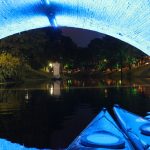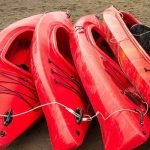Welcome to Tips For Better Kayaking at Night!
Kayaking is a fun and exhilarating experience, but paddling under the stars adds a whole new level of adventure. However, kayaking at night can be challenging and requires extra caution to ensure your safety.
In this article, we will provide you with essential tips and tricks to make your nighttime kayaking experience more enjoyable and safe.
Whether you’re a beginner or an experienced kayaker, these tips will help you navigate the waters with confidence and ease. So grab your paddle and let’s get started!
Is It Safe To Kayak At Night?
There is undeniably a greater chance of potential dangers when kayaking in the dark, but if guidelines are pursued then it can be secure. Making sure you have the right gear and that you are ready for whatever situation may arise.
The principal distinction between kayaking in the daylight and kayaking in the dark is that it is dark at night, which leads to significantly reduced visibility. Your vision won’t be as clear and both you and your kayak will be much harder to detect on land and on the water.
It is essential to take extra precautions when paddling during the night in order to reduce your risk, in addition to the normal safety steps you would take for daytime paddling. This concept is relevant both when you’re sailing in a lake with a few boats around or navigating a sound with bigger boats cruising.
Be mindful that other ships may have a harder time spotting you at night and thus have a tougher time avoiding you if you don’t show yourself.
At night, it is more likely you will meet wildlife, which can be risky. Although you may not be visible, they might still be able to spot you, or your actions might unintentionally anger them, leading to a hostile response. The kind of animals you come across will definitely depend on where you are, which means it is possible you will see a daring alligator or bear.
Illumination can have a substantial impact on making you more evident to others, for instance, it helps people spot you on the lake as well as allowing you to determine where you are heading. It would be wise to organize beforehand and let a person on land be aware of your destination and the estimated time of your return.
Kayaking At Night: Laws And Regulations
When kayaking in the dark, there are particular regulations that should be followed, which could be imposed by either the US Coast Guard or the respective state government, depending on the area you paddle in.
Kayaking is not allowed at certain bodies of water in the dark, typically for safety worries or the spot. Certain state parks or boat launches could lock their doors prior to the sun setting.
When kayaking or canoeing at night on lakes or rivers, you must follow the rules. It is usually necessary to have lights when paddling after dark, regardless of location.
The US Coast Guard regulations for kayaking at night include:
- A white light must be carried on board all kayaks and canoes between sunset and sunrise. This can either be a permanently displayed lantern or a handheld waterproof flashlight, as long as it can be displayed in enough time to prevent a collision.
You may also need to display a white light if your kayak is anchored in a channel or normal navigation area.
- Visual Distress Signals (VDS) are required to be carried by all vessels on coastal waters between the hours of sunset and sunrise. For kayaks, this can include either three handheld red flares or one electric distress light.
- A whistle, or other suitable sound-producing device, is required for kayaking in most waters both during the day and at night.
How To Go Kayaking At Night…Safely
Be Visible
It is essential to enhance your perceptibility for others on the water when going out kayaking during the night to ensure safety. This can help you to stay clear of collisions with other boats.
All nighttime vessels must have lights, regardless of whether the water is in a state or federal area. It is best to adhere to the regulations for lights, even if they don’t apply to the particular body of water in which you are navigating.
Attaching an all-encompassing white light to your kayak can be a safer option than carrying a handheld flashlight, since it can be activated and remain illuminated throughout the entire paddling session.
You can decide to put reflective decals or strips on your skateboard, paddle or life jacket. Some PFDs will have reflective fabric for added visibility.
Wear Your PFD
In every territory and marine area, you must have a PFD (Personal Flotation Device) in possession when in the kayak. The life vest must be in the correct dimensions and in proper working condition.
It is not mandatory in most states to wear a personal floatation device (PFD), but it is highly advised that you do so constantly. It is absolutely vital to put on a life vest when kayaking in the dark, as help may take longer to arrive than during the daylight hours.
A personal flotation device can be the difference between life and death if it is worn correctly.
Carry A Radio
Bringing a two-way radio or walkie-talkie with you can be beneficial, as you can communicate with someone in a crisis.
Certain marine radios contain channels specifically designed to provide weather warnings, which can be useful in situations when you’re out on the water for a prolonged period of time.
Carry A Personal Light
Despite the white light on your kayak that serves the purpose of making you visible to outside boaters, it is advantageous to have an additional source of illumination, like a lantern or headlamp, to help guide your path.
In addition to being able to view the path forward, it should also be able to illuminate your deck if you need to access anything from your baggage holders or compartments.
Be sure to place your must-haves near your chair, so you don’t have to search a lot. Put small and expensive possessions in a sealed waterproof pouch so you can easily find them.
Check Your VDS Devices
If you’re exploring waters near the coast, or lakes, make sure to bring Visual Distress Signals with you. Ensure that your electric distress light is functioning well before you embark on your journey.
Ensure the red flares you choose to bring are not outdated if you decide to take three.
Plan Your Route
Familiarizing yourself with plotting out your course is an important factor to consider when you are going out to paddle during the day. Kayaking at night can be especially critical, as there could be less external help available if an issue arises due to less people being on the water in comparison to the day time.
Compose a plan for your boat trip and give it to a reliable person on shore. Ensure you remain on your intended path when leaving or inform the person that you are taking a new direction, in order to avert an unnecessary search team being formed.
Using maps and a GPS could be beneficial to ensure you stay on the path you have planned and not wander off course.
Be sure to look up the forecast before setting out on your journey, and don’t forget to stay tuned to a weather station on your radio.
Keep An Eye On The Tides
It would be advantageous to verify the tide before you go kayaking on the coastal or tidal waters. When kayaking after dark, it may be more difficult to accurately spot the tide movement, therefore, it is even more important to verify the periods of high and low tides.
The height of the tide will fluctuate according to your geographical area, but you can research the tidal trends and movements throughout the US by visiting this resource.
Don’t Kayak Alone
It is sensible to avoid kayaking alone in the dark. Having another individual nearby when you’re out on the water in the evenings can be critical to your survival in case of an unexpected situation. Fewer individuals are out then, meaning you may have no one else to turn to for help.
In the event of an incident with either yourself or your paddling companion, one of you can summon assistance or work to aid in self-rescue should you flip over.
The Ultimate Guide to Choosing Kayak Lights
Let’s explore the essential information that you need to consider when selecting the optimal kayak lights. We’ve given you a lot of different choices, each one with a different look, different properties and purposes. It is essential to understand what use each type of light fulfills so you can select the one that best matches your requirements.
Types of Kayak Lights
There are basically four types of kayak lights to consider:
Handheld Lights
Fishermen and boaters typically use handheld flashlights and spotlights. The market presently offers a very vast selection of marine spotlights and highly powerful LED torches.
Nevertheless, not many have the intense waterproofing that is necessary to safeguard the flashlight in case it tumbles off the boat or your kayak tips over. You must have the flashlight in your grip, so you won’t be able to both illuminate and use the paddle simultaneously.
Helmet Lights and Headlamps
Headlamps are commonly used by those who participate in outdoor activities during the night, such as hunters, fishermen, hikers, snowboarders, snowshoers, and skiers. They’re small, compact, and totally hands-free.
You can wear some protective headgear directly on your head using an elastic band so it will stay on. Others are connected or fastened onto a helmet. A headlamp is very useful for kayak fishing when there is not much light.
The downsides of headlamps and helmet-mounted flashlights are:
- They’re not always very waterproof
- They may slip off your head/helmet if you capsize
- They’re not the brightest light source.
Clip-on Lights
Clip-on lights are typically small torches that can be fastened to your life vest using a carabiner or clasp. These items provide effortless and convenient access – you will never have to wiggle around in the boat to wear them since they are held right at the life vest.
Nevertheless, as they are minuscule, they will not produce great amounts of light, which makes them much less noticeable compared to other alternatives.
Deck-Mounted Lights
Boats usually have navigation lamps that are fixed onto the topside and sides of the boat. Many kayak lights are structured in a similar manner.
These lamps are typically attached to the vessel’s surface and are powered by their own battery (rather than connected to the motor or battery of the vessel).
How Do You Mount Lights on a Kayak?
There are five basic mounting options available:
Clamp-on
This kind of mount is essentially a large metal C-clamp which you fasten to your kayak. Kayaks with sit-on-top designs are normally most advantageous for the shape of the majority of kayak hulls.
These mounts are strong and stable, so they will not move or slide once they have been firmly affixed. Nevertheless, they are cumbersome, cumbersome to control, can only be fixed in determined places on the kayak, and might damage the body if tightened excessively.
Suction Cup
This is an option that has gained immense popularity in the last few years and is considered to be quite up-to-date. Suction mounts have a solid rubber cup which creates a vacuum when it is put against the surface of the vessel, allowing the mount to be held in place without a big and cumbersome mounting system.
Be conscious of the fact that in order for the suction cup to stick, it requires a spotless and even surface. If your kayak has dirt, dents, or scratches on it, it may not offer a very strong grip.
Tension Cable
Cables intended to provide tension can be fastened onto the eyelets or D-shaped rings placed on the top of a kayak. The fastener is incorporated into the foundation of the lamp, enabling it to lightly swing and flex downward when needed.
This is a practical alternative if your deck has the necessary fixings to attach the light fixture to. Still, if it’s not secured firmly, you may end up continually stabilizing a lantern that topples over in rough waters.
Track Mount
The utilization of gear tracks on kayaks is becoming increasingly frequent, especially those which are intended to be used for the purpose of fishing. These tracks are advantageous because they offer a secure way to attach additional hardware and accessories to the top of the kayak.
Some kayak lights have been constructed to be affixed to the kayak’s item racks. These mounting options are exceptionally secure and straightforward to use; however, they will only be beneficial if your kayak has the appropriate accessory tracks, and in some instances, only a certain style of track.
Drill Mount
Drilling into the deck or hull is usually the best choice when it comes to attaching kayak accessories. Most lights that are attached to a drill use plates that get attached to the kayak by means of screws and bolts.
They are the safest route to take, however, you have to be okay with drilling openings in your kayak. When placing these, they cannot be adjusted afterwards so be sure of where you want them to be when doing it initially.
Final Thoughts
Kayaking after sundown can be an exhilarating experience, but it also comes with an increased risk factor.
Be sure to have your life vest and make yourself more visible by having a bright white light on your kayak; this is in compliance with the rules.




